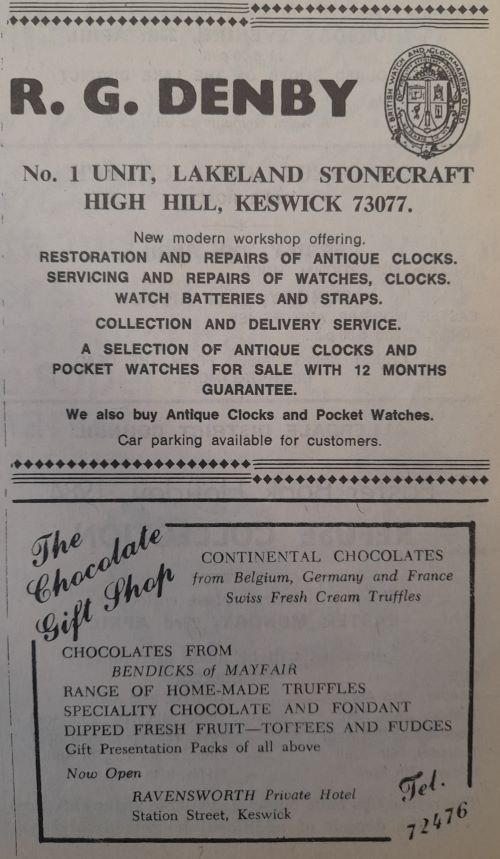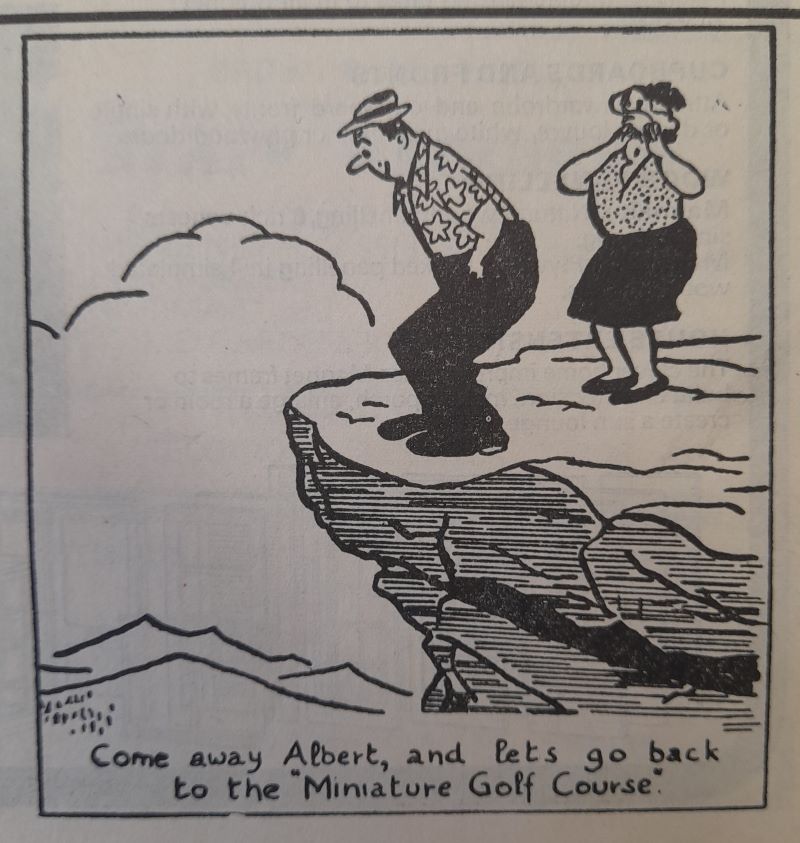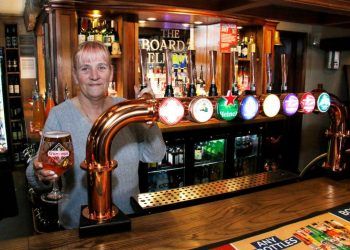
A Quick Reminder: Looking back through the archives of The Keswick Reminder from around this week 20, 30, 40 and 50 years ago.
20 years ago
Island house tenants wanted
A new tenant is being sought for an exclusive Lake District property which has some unusual conditions attached to the lease.
The tenancy for Derwent Island House, which is owned by the National Trust, is on the market as the departing tenant, retired surveyor and writer John Ryde, leaves this exclusive property which has an equally exclusive rent – £3,000 per month. Derwent Island House, which was built by local eccentric Joseph Pocklinton, and is located on Derwent Isle, in the middle of Derwentwater, can only be reached by boat. Donated to the National Trust in 1952, the property dates back to 1780 and has undergone extensive renovations with the help of tenants.
The Grade II listed Georgian property has six bedrooms, five reception rooms, a billiard room, a former chapel and boat house along with several store rooms.
Mr Ryde said the island was magical although perhaps less so when the gales blow across the lake and a well stocked freezer is an advantage. It took the previous custodians, Peter and Vanessa Sorton, 35 boat trips to move their belongings in and they were also iced in for ten days during their stay.
Included in the unusual conditions of the lease is that somebody lives on the island all the time and they must inform the Trust whenever they are more than half an hour’s drive from the island; also tenants must open the house to the public for five days a year.
Lakeshore development update
A project manager has been appointed to co-ordinate the management for the two schemes involved in the proposed Derwentwater Foreshore project. Patric Gilchrist, Theatre by the Lake’s executive director will tie in the role of the Theatre with improvements to the area which could eventually cost millions of pounds.
Allerdale Borough Council has extended a review of the options for regenerating the lake foreshore to involve the Tea Gardens and theatre and proposals include a permanent building, which could provide further theatre and restaurant facilities and an upgrade of all the amenities as part of a “major scheme”.
The Council’s executive says that co-ordinating the management of the two projects for the foreshore and theatre will be similar and has confirmed that it will be serving notice on the present tenants of the Lakeside Tea Gardens. It will also be drawing up a building lease agreement with Cumbria Theatre Trust relating to the Tea Gardens site overlooking one of the Lake District’s most famous and visited viewpoints, that of Derwentwater from the boat landings.
30 years ago
Rescue team H.Q. hopes
Keswick Mountain Rescue Team is one of the busiest in the Lake District but the task of finding casualties on the fells is probably not as difficult as that of finding a suitable site for a new headquarters building!
The Team has been searching for a new site in Keswick for two years as there is a compelling need to move from their present cramped accommodation in a garage on the Central Car Park ring road. The chairman, Mick Guy, says about a dozen sites have been considered but for various reasons none of them has proved practicable.
Now, however, a site just off Borrowdale Road adjacent to Castlehead House has become available and the Team is anxious to win planning consent and get the development off the ground.
The Team would like to have the new HQ ready in time for its 50th anniversary in 1997. Mr Guy says the new premises could cost in the region of £150,000.
40 years ago

When huntsman Johnny was hunted
Today Johnny Richardson is Huntsman to the fell hounds of the Blencathra Pack, in Threlkeld, Cumbria. But forty years ago he himself was being hunted, through the mountains of Central Italy, by German soldiers as an escaped prisoner of war.
The fascinating story of Johnny Richardson’s wartime adventure is told in a special programme on BBC Radio Cumbria, “One Man’s War,” at 11-00 am. on Easter Monday.
Johnny left his beloved Lake District to join the Army at the beginning of the 1939-45 war and was captured by the Germans in Tobruk. He was shipped to a prisoner of war camp in Italy, from which he escaped three times. Twice he was recaptured, but the third time he was sheltered by a family in a village in the mountains. He worked with them and even walked openly through the village, where all the locals shared the secret of “the Stranger in the town.” As the advancing Allies got closer, Johnny left the village to join them.
Forty years later he returned to the village to meet again the family who risked their lives to save him.
Johnny tells his real life adventure story in rich Cumbrian dialect to Rod Macrae in the programme, which is presented by Kath Worrall.
M.P.’s explanation of hi-tech park plan
As controversy grows over a high-technology industry scheme in the National Park, Workington M.P. Dale Campbell-Savours told the “Reminder” this week that ‘many people had misunderstood what was intended.
“People have blown the whole thing out of proportion,” he said. “There are no proposals for the establishment of an industry park right on the shores of Bassenthwaite.”’
The high-technology park is the brainchild of Mr. Campbell-Savours and Allerdale Planning Committee chairman Bob Cattanach, and the M.P. has given a full copy of correspondence he sent to Mr. Cattanach outlining his researches into the issue.
Mr. Campbell-Savours said a mutual preference appeared to be for a site preferably adjacent to Bassenthwaite Lake, if possible overlooking the lake, situated in “recessed land” so as not to damage the visual landscape. He feels that a lot of people have developed the image of lake shore industry because, in his letter to the Planning chairman, he made reference to a Wordsworth poetic setting “beside the lake beneath the trees.”
Mr. Campbell-Savours said this week that the sort of people who would be attracted to work in the industry would probably be environmentalists and walkers, not the sort who would want to take part in any venture which would damage the Lake District. But he pointed out if Cumbria wished to succeed in attracting high technology companies, they would have to use the Lake District as a carrot.
Mr Campbell-Savours stated in his letter that Allerdale and the County had been unsuccessful in attracting significant high-tech industrial activities over the past few years and yet at a time when the Government had repeatedly exhorted local authorities to place greater emphasis on such development.
He said the brain drain from West Cumbria had reached chronic proportions and meant the area had lost many of its higher scientific types to the major centres of industrial activity in other parts of the country.
50 years ago

The road to Watendlath
Dear Sir, — Having read in the “Keswick Reminder” of the proposed traffic control experiments on the road to Watendlath, I venture to offer a purely personal solution to this problem. It is that a traffic sign should be placed at the junction of the Watendlath lane and the Borrowdale road, reading “Unsuitable for motor vehicles.” Clearly exceptions would be made in the case of Watendlath residents; but this lane provides perfect country walking and should be allowed to preserve its peace. I am bound to add that I write as a motorist who has been thankful for the use of a car in the Lake District, and therefore have a guilty conscience; but the spectacle of controlled convoys making the Watendlath pilgrimage appals me.
Yours faithfully,
Barbara Lupini
Hedge Barton,
Fordcombe,
Kent.
Diamond wedding
A local couple, Mr. and Mrs. Joseph J. Graham, Wordsworth Street, Keswick, celebrated their diamond wedding last Thursday with a family party in a local hotel.
Born at Maryport, Mr. Graham moved to Dalston, near Carlisle with his parents and later served his time as a gardener at Rose Castle, the residence of the Bishop of Carlisle. He later worked at Keswick and at Lamplugh until the 1914-18 war when he joined the South Lancashire Regiment as a volunteer and served with them in Africa, on the North West Frontier and during the Afghan war.
After the war he returned to the Keswick area, where he was a member of the St. John’s Ambulance Brigade for 28 years and he was closely involved during the last war in operations involving crashed aircraft on the fells, having been one of the men who took the first ambulance box to the top of Styhead. He later moved to Liverpool to work and returned to Keswick in 1967.
Mrs. Graham, whose father was a quarryman at Honister, lived at Seathwaite, Borrowdale, and met her husband when she was in domestic service in Keswick.
Mr. and Mrs. Graham have two sons, Mr. Tom Graham, High Hill, and Mr. Joe Graham, The Headlands, and a daughter, Mrs. Mary Bacon with whom they live.








